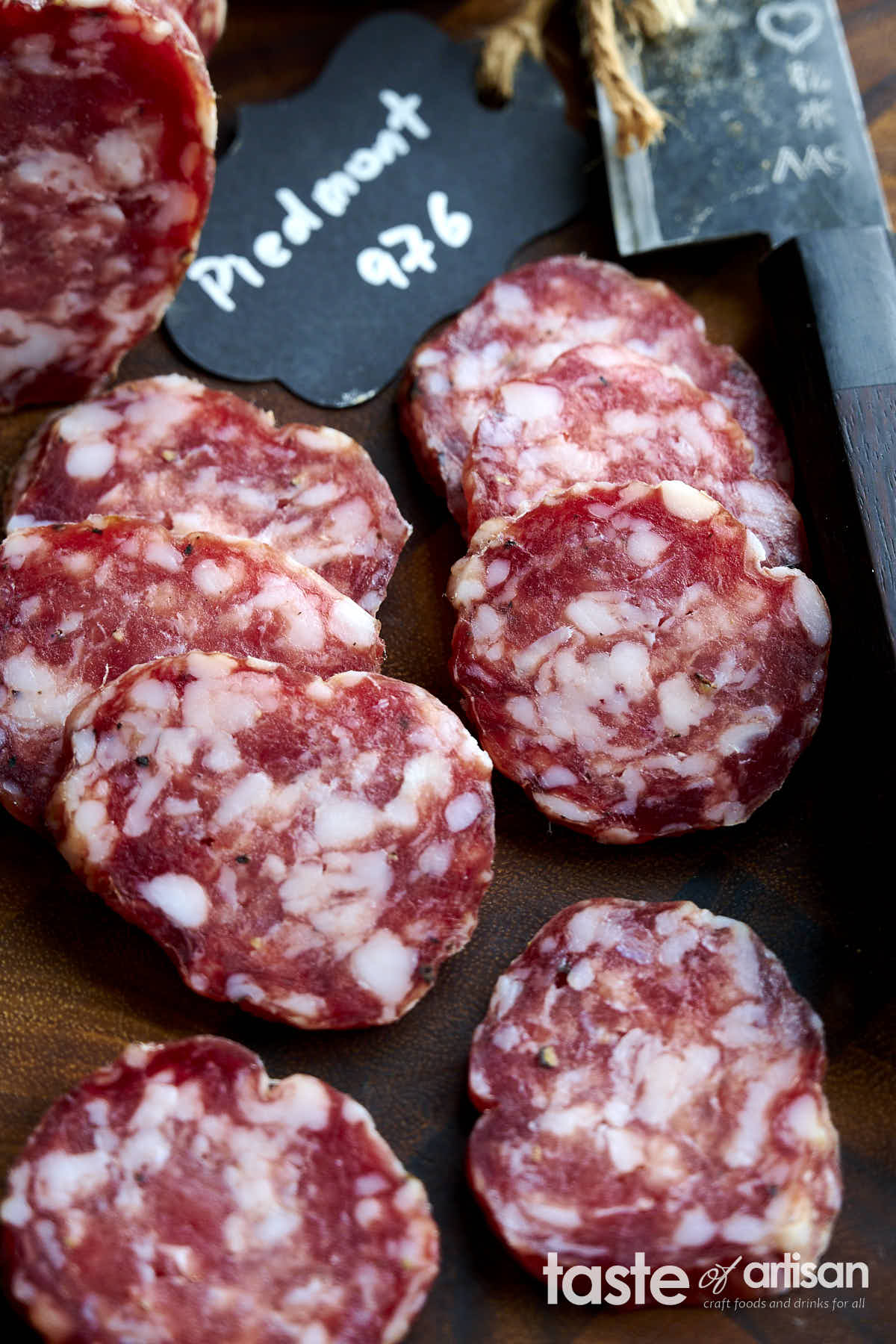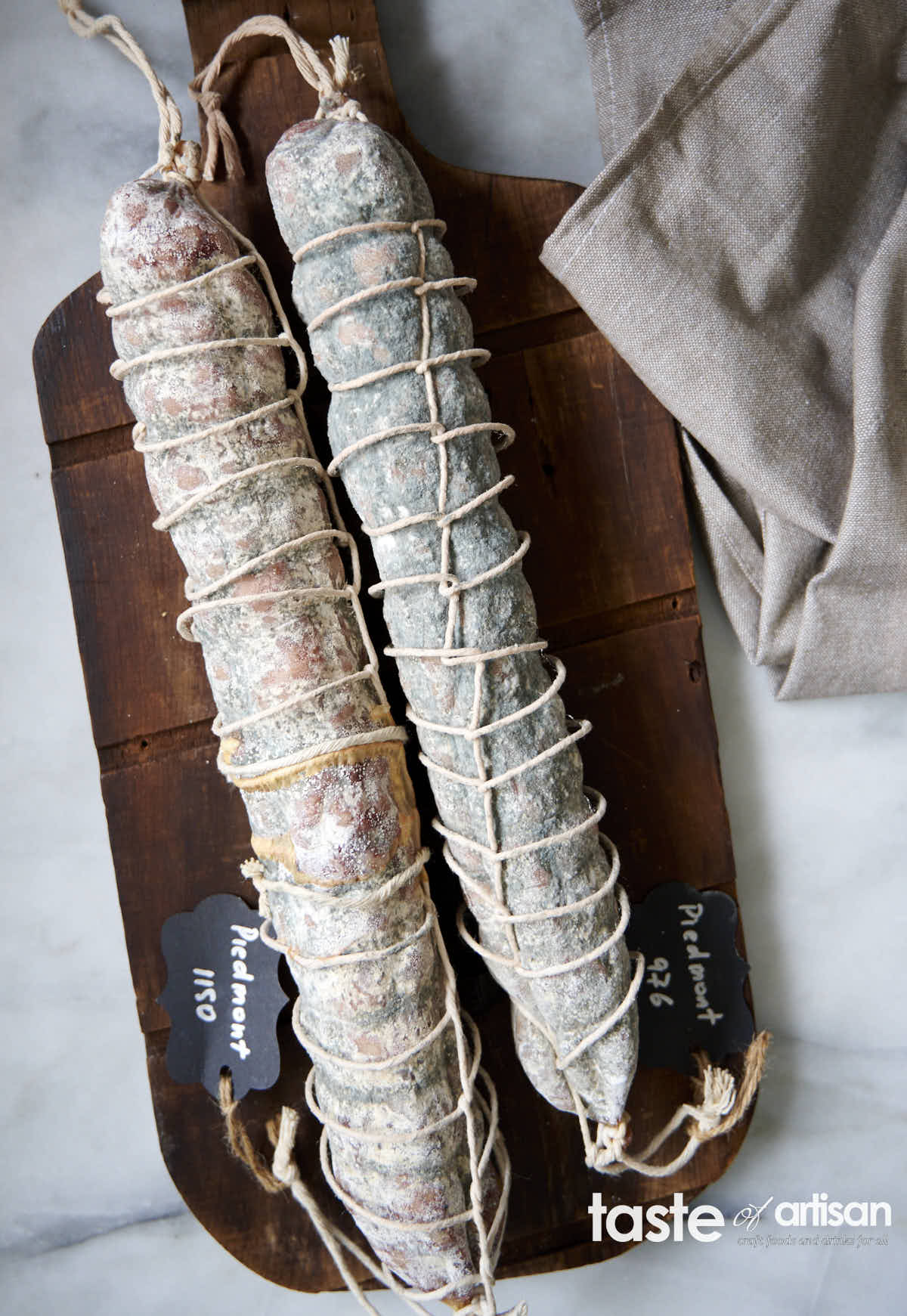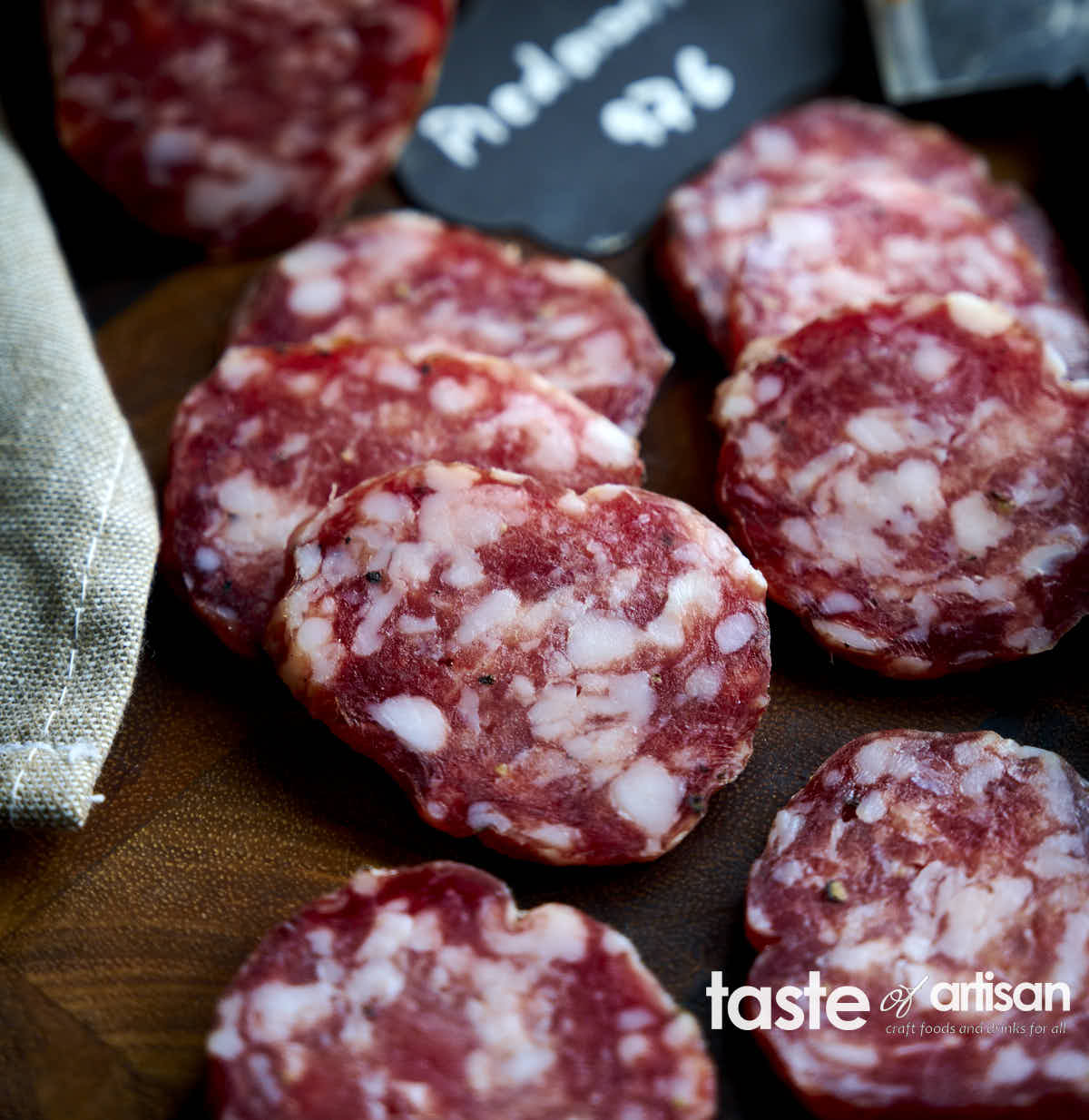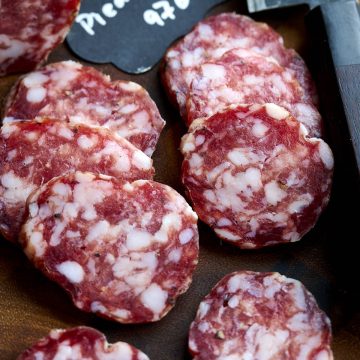Piedmont salami is among the top 5 best salamis I've ever tasted. The mild acidity, the delicate sweetness of the pork, the aroma of aged cheese, the hints of garlic, and a touch of spiciness all create a superbly enjoyable charcuterie product.

Piedmont salami is native to the Piedmont region in Italy and dates back to the end of the eighteenth century. In 1854, Giovanni Vialardi, royal head chef of the House of Savoy, described the method of making pork salami with a recipe similar to this one, which included the addition of a glass of good barbera wine. The addition of red wine with a designation of origin, obtained from Barbera, Nebbiolo, and Dolcetto grapes, the three most famous wines of Piedmont, shows the strong connection of this salami to the Piedmont region.
Making Piedmont Salami
According to ISIT – Istituto Salumi Italiani Tutelati, Piedmont salami is typically made from a mixture of fresh (not previously frozen) lean meat and fat. Lean meat may come from the leg or shoulder, while the fatty part may come from the noble fat of the belly, throat, or back.
Both the meat and the fat are ground through an 8-10 mm grinder plate. The meat for Salame Piemonte is seasoned with salt, pepper, garlic, cloves, nutmeg, and, invariably, red wine from Piedmont. The ground meat and spices are then mixed long enough to obtain the characteristic elongated shape of the fat pieces.
The meat is stuffed into natural casings or reconstituted casings of natural origin and then tied with twine.
It's worth noting that traditionally, meat for Piedmont salami is dried in well-ventilated cold rooms prior to grinding and stuffing. This results in a shorter drying time, which promotes softness and the delicate flavor characteristic of this salami. I have yet to experiment with pre-drying meat before making salami, but it sounds like an interesting approach to explore in the future.
Finally, salami is dry-cured in well-ventilated rooms for a period that varies depending on the diameter of the fresh salami: 10 to 50 days for salami with a diameter between 40 and 70 mm, and 21 to 84 days for salami with a diameter between 71 and 90 mm. Of course, without the pre-drying of the meat, expect these timelines to be longer. However, you can shorten the drying time using my accelerated salami drying protocol, which I described in detail in my Salame Toscano and other posts.
The final PH of the salami should be 5.2 or greater.

Tasting notes
This salami has a delicate smell of aged cheese, wine, and a hint of garlic. It has a pleasant aged pork aroma. Excellent acidity, very mild, just right. The taste is sweet and delicate, just a touch spicy from pepper and nutmeg, with good aromatic persistence and balanced saltiness.
Overall, this salami has fantastic flavors and taste, but this particular batch of salami was on the fattier side, as you can see in the pictures. The higher fat content was somewhat intentional.
You see, the specifications for this salami allow for the fat/protein ratio to be a maximum of 1.40. This prompted me to experiment, and instead of using only lean meat and fat, as specified in the recipe below, I used a mix of lean meat and some fatty trimmings on top of the 25% fat. That drove the fat content higher. I can't say how much higher exactly, but I wished I hadn't done it. Twenty to twenty-five percent fat content is where I like my salami to be, nothing more.

Every family member agreed, though, that the flavor of this salami was excellent, but the excessive fat detracted from the sausage's enjoyment. I would be careful not to add any additional fat to this salami.

Ingredients
- 750 g lean pork from leg (ham), shoulder, or neck (coppa)
- 250 g pork fat from pork belly, jowl, or back fat
- 25.5 g sea salt
- 2.5 g Cure #2
- 2 g dextrose
- 2 g sugar
- 2 g coarsely ground black pepper or to taste, max 4 g
- 0.5 g nutmeg freshly ground
- 0.02 g cloves 0.02 g is a tiny amount that fits on the tip of a knife. Cloves go a long way to it's important to not add too much.
- 0.12 g T-SPX culture
- 20 ml red wine (preferably Piedmontese) min 2.5 ml
- 1/4 clove garlic pressed or crushed
- 60 ml distilled water
Instructions
- Crush or press the garlic and place it in a small cup. Add the wine and let it infuse for about 30-60 minutes. Strain the wine to remove the garlic.
- Rehydrate the starter culture in 60 ml of distilled water. (see notes)
- Weigh the lean meat and the pork belly/back fat in grams. Calculate the rest of the ingredients, except the distilled water, which may remain the same (see notes), weigh them out, and set aside.
- In a small bowl, combine the salt, Cure #2, sugar, dextrose, pepper, nutmeg, and cloves.
- Cut the lean meat into 2-inch pieces. Cut the fat into small cubes, about 3/4 - 1 inch.
- Freeze the meat and the fat for 30 minutes.
- Sprinkle the salt and seasoning mixture over the meat and fat and mix so it is evenly distributed.
- Grind through a 3/8″ (10 mm) grinder plate.
- Combine ground pork with the rehydrated starter culture and strained red wine. Mix well until sticky, and the characteristic elongated shape of the fat pieces is obtained. It helps to use a stand mixer with a paddle attachment or a meat mixer.
- Stuff into 40-90 mm natural casings and tie with twine.
- Using a sterilized needle or sausage pricker, prick holes across the entire salami.
- Weigh the salami, write down its weight on a tag and attach the tag to the salami.
- If desired, inoculate with (penicillium nalgiovense, penicillium salamii) mold.
- Use the leftover meat from the stuffer/stuffing tube to make a small sample for measuring the initial pH and the pH at later stages. Make sure to record the readings.
- Ferment and dry at 59F - 75F (15C - 25C) and 65% - 86% RH for a period of 7 days as per the drying protocol in the notes. Measure the pH; it should be below 5.3 at this point.
- Mature in the curing chamber at 55F - 57F (13C - 14C) and 75-78% RH for about 1-3 months, depending on the diameter of the salami, until 35% weight loss is obtained.
Alternative Fermentation/Curing Method
- Ferment salami at around 70-72F for three days to get the pH below 5.3.
- Cure at the standard 55F-57F and 75-78% RH until 35% weight loss is obtained.
Notes
| Stage | Duration | Temp | RH |
|---|---|---|---|
| Fermentation | 12 hours | 75F (25C) | < 99 % |
| Drying | 17 hours | 72F (23C) | 75-85 % |
| Drying | 24 hours | 71F (22C) | 68-78 % |
| Drying | 24 hours | 68F (20C) | 65-75 % |
| Drying | 24 hours | 64F (18C) | 68-78 % |
| Drying | 24 hours | 61F (16C) | 72-82 % |
| Drying | 24 hours | 59F (15C) | 76-86 % |
Nutrition


Tom Pitman says
Hey. Your charcuterie looks excellent! Have you ever done a “gentile” salami? I’ve been looking for a recipe and can’t seem to find one. Sure would love to make some. If you have a recipe to
post that would be awesome.
Thanks
Tom
Victor @ Taste of Artisan says
Hi, never made it but a quick Google search came up with several recipes. Looks like the trick of that salami is to use a thick casing like Hog Bung also known as the budello gentile, hence the name. Good luck!